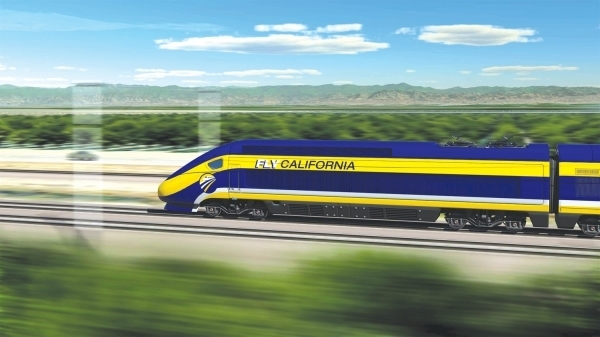The cost of California's proposed high-speed rail system would drop by $30 billion from earlier estimates under a revised business plan released Monday morning, April 2.
The plan, which the California High-Speed Rail Authority's board of directors plans to discuss April 12, commits to building the system through a "blended" design under which high-speed rail and Caltrain would share two tracks on the Peninsula. It also calls for early investment in the northern and southern segments of the San Francisco-to-Los Angeles line, even though construction is still slated to begin in the Central Valley.
The rail authority's previous business plan had pegged the cost of the system at about $98.5 billion, far higher than initial estimates of about $40 billion. California voters had approved a $9.95 billion bond for the project when they approved Proposition 1A in 2008.
"The benefits of investing in high-speed rail will be delivered far cheaper than previously estimated," the revised business plan states. "Through the adoption of a blended approach, the Authority has confidence that the cost of delivering the San Francisco-to-Los Angeles/Anaheim system, in accordance with Proposition 1A performance standards, is reduced by almost $30 billion, now estimated at $68.4 billion."
The new plan also specifies that the first "initial operating section" of the line (the first stretch that would be used by high-speed trains) would stretch from the Central Valley to southern California. According to the new document, it would extend from near Merced to the San Fernando Valley en route to Los Angeles.
The section, the plan states, "will be transformational in creating a passenger rail nexus between one of the fastest growing regions in the state with the state's largest population center."
The rail authority has scheduled a press conference to discuss the new plan at 10 a.m. Monday.



Comments
another community
on Apr 3, 2012 at 11:38 am
on Apr 3, 2012 at 11:38 am
The new plan for high-speed rail, with sensible changes in alignment and the reduction in cost, is a very positive step forward. Meanwhile, the arguments put forth by opponents of California's high-speed rail project have not changed, consisting almost entirely of calling it a boondoggle and loudly branding the experienced rail professionals as stupid. ("Loud" is an essential element to the anti-rail argument.) Those who understand and support high-speed rail must persevere, because it has been proven both popular and successful everywhere else in the world for more than 30 years. (They are building a high-speed rail line in Uzbekistan, for heaven's sake!) In particular, Governor Jerry Brown is to be congratulated and admired for having the political courage in today's highly-charged partisan environment to stand firm in support of the project and against the ideologues and the yahoos.
Menlo Park: other
on Apr 3, 2012 at 12:57 pm
on Apr 3, 2012 at 12:57 pm
Well Jim, just how do you suppose we are going to pay for HSR? It was sold on a pck of lies and is now in full bait and switch mode. It won't deliver anything that was promissed and will be a huge money suck for the rest of our lives, our childrens lives and there children's lives. We don't have the money. What part of that don't you understand?
Woodside: other
on Apr 3, 2012 at 2:20 pm
on Apr 3, 2012 at 2:20 pm
The PROJECTED costs for government projects go down all the time. Bureaucrats just keep sharpening those pencils until voters say "yes."
But does anyone believe the ACTUAL cost will be lower? If so, I have a very cheap Bay Bridge to sell you. I'll even sell it at the PROJECTED cost. It'll be a bargain.
another community
on Apr 3, 2012 at 6:35 pm
on Apr 3, 2012 at 6:35 pm
There is a another thread on this topic, based on an updated version of the story: Web Link
Atherton: West Atherton
on Apr 3, 2012 at 8:54 pm
on Apr 3, 2012 at 8:54 pm
So there is yet another estimate of costs, again from those who will not be around to be accountable for them, or at least not risking their own money. Let us see who will commit to provide the rest of the money, even if still more is needed, before we go ahead. Could we be getting a message because such funding is still uncertain?